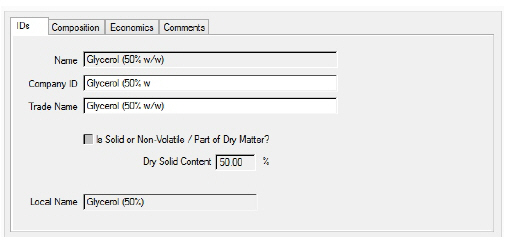

This tab is part of the Stock Mixture Properties Dialog.
The ID strings currently associated with a stock mixture are:
● Name
This represents the formal name that uniquely identifies the stock mixture in the system or user’s databank. No two stock mixtures can exist in the database with the same name. It can be any string up to 31 characters long. The name of a stock mixture is only editable the first time a mixture is introduced in either the active process file or the user database. After a stock mixture is defined, its name cannot be edited. You must delete (remove) the mixture and re-introduce it if you need to make changes to its name.
● Trade Name
It can be any string (up to 31 characters long) used to identify mixtures that are better known with their trade names (rather than their formal names). Even though it is allowed to have duplicate trade names in the stock mixture databank, it is not recommended as a good practice. The trade name of a stock mixture can be edited at any time.
● Company ID
Often mixtures are identified and tracked within corporations with a company-wide tag ID number. This field is reserved to contain exactly that description. It is provided when the mixture is originally introduced (either to the databank or the process file), but it can be changed later (uniqueness is not required). It can be a string of up to 31 characters.
● Local Name
The local name of a stock mixture (just like the local name of a pure component) is a string shorter than its formal name (up to 15 characters) by which SuperPro Designer will refer to the mixture when listed in stream composition dialogs, reports etc. When the stock mixture properties are viewed in the context of either the system or user databank, the local name string will be the default string that SuperPro Designer will use every time the mixture is registered in a process file. The local name field is always editable for stock mixtures listed in the user’s databank. Modifying the string, will result in SuperPro Designer using the new string as the default local name from that moment onwards, everytime that mixture is registered in a process file. Note that changing the local name of a mixture in the user databank will NOT affect any stock mixtures already registered in pre-existing process file files.
|
|
The local name of a stock mixture registered in a process file is only editable the first time the mixture is registered. After that, the only way to change the local name of a registered mixture would be to delete (remove) it from the process file and re-introduce it with a different local name. However, doing so will result in loss of any information kept in the process file regarding that mixture. |
● Is Solid or Non-Volatile / Part of Dry Matter?
If this box is checked, then this stock mixture is considered (in its entirety) as a counting towards the Dry Matter content of a stream (or equipment contents). This box is NOT checked by the user; it is determined automatically by the program based on the ingredients that are present in the composition of the stock mixture and whether every ingredient is tagged as “Dry Matter” or not. If all ingredients are tagged as “Solid or Non Volatile / Part of Dry Matter” then, the stock mixture will show as such. If at least one of the ingredients is not tagged as dry matter, then this box will not show as checked. Note that if the box is not checked, it does not automatically mean that the stock mixture is in its entirety non-dry-matter, i.e. aqueous; it may or it may not be; it could be indeterminate as some ingredient(s) may be aqueous and some may not. If the dry solid content percentage (see below) is shown as 0.0%, then one can safely assume that all constituents in this mixture are aqueous.
● Dy Solid Content (%)
This percent represents the g/g dry solid content of this mixture. If none of its ingredients are dry solids, then it’s 0.0%. If at least one of its constituent pure components is tagged as part of dry matter family, then it will be non-zero. Note that if all of its constituent components belong in the dry matter family, this mixture will show as “Is Solid or Non-Volatile / Part of Dry Matter”, but the dry solid content may not be 100%, as one or more of the constituent components may not have a 100% dry solid content.